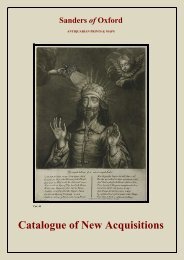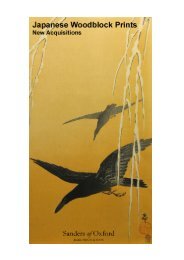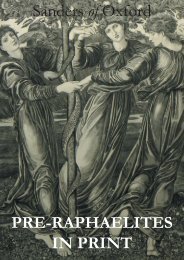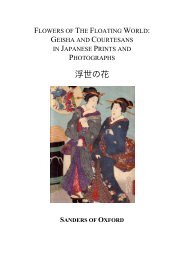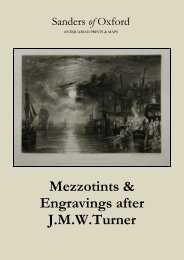catalogue text.indd - Sanders of Oxford
catalogue text.indd - Sanders of Oxford
catalogue text.indd - Sanders of Oxford
Create successful ePaper yourself
Turn your PDF publications into a flip-book with our unique Google optimized e-Paper software.
George Jones (1786 - 1869) was a British painter and draughstman. Son <strong>of</strong> the engraver, John Jones, George was<br />
noted for his militaristic, historical and biblical painting. He joined the Royal Montgomery Militia in 1812, and was<br />
part <strong>of</strong> the army <strong>of</strong> occupation in Paris after the Battle <strong>of</strong> Waterloo. Jones became a Royal Academician in 1824; and<br />
would later become the librarian and keeper <strong>of</strong> the institute.<br />
James Northcote (1746-1831) was a history and portrait painter, he was also the assistant to Sir Joshua Reynolds, and<br />
later, his biographer. He was known for his dignified portraits in the Reynoldsian tradition, but also produced grandiose<br />
history paintings, many for Boydell’s Shakespeare Gallery.<br />
Georg Emmanuel Opiz (1775 - 1841) was a painter, draughtsman and printmaker. He was born in Prague, but received<br />
his initial training from Giovanni Battista Casanova in Dresden. He relocated to in Vienna in 1801, and became a specialist<br />
in amusing scenes <strong>of</strong> everyday life, particularly Parisian. He was somewhat nomadic, and moved to the French<br />
capital in 1814. After this, further trips to Heidelberg and Attenberg followed, before he settled in Liepzig in 1820.<br />
Robert Andrew Riddell (1793 - 1796; fl.) was a Scottish landscape painter. He is best known for his watercolour representations<br />
<strong>of</strong> the Scottish topography. He exhibited at the Royal Academy in 1793, and lived in Bloomsbury, London,<br />
where he published aquatints after his own works. The famed Scottish poet, Robert Burns, is believed to have owned a<br />
large number <strong>of</strong> Riddell’s watercolours.<br />
David Roberts RA (1796 – 1864) was a famed Scottish painter. He is especially known for a prolific series <strong>of</strong> detailed<br />
prints <strong>of</strong> Egypt and the Near East produced during the 1840s from sketches made during long tours <strong>of</strong> the region<br />
(1838-1840). This work, and his large oil paintings <strong>of</strong> similar subjects, made him a prominent Orientalist painter. He<br />
was elected as a Royal Academician in 1841.<br />
Fred Taylor was born in London on March 22 1875, the son <strong>of</strong> William Taylor. Taylor studied briefly at Goldsmith’s<br />
College, London, where he won a gold medal for his posters, and a travelling scholarship to study in Italy. At some<br />
point working in the Waring and Gillow Studio, Taylor was a poster artist, illustrator, decorator and a watercolourist.<br />
Particularly noted as a poster artist from 1908 to the 1940s, and was regularly commissioned by the LNER, EMB and<br />
shipping companies. Taylor also exhibited regularly at the Royal Academy, and other provincial societies. Taylor’s<br />
designs frequently referred to architectural subjects.<br />
During the Second World War, Taylor was employed on naval camouflage. He also executed commissions for London<br />
Transport, including ‘Back Room Boys’, where the underlying concept and use <strong>of</strong> central image with a surrounding<br />
border were probably taken from A S Hartrick’s series <strong>of</strong> lithographs on war work called Playing the Game, 1918,<br />
although ‘their finely balanced colouring and their superb draughtsmanship are peculiar to Taylor at his best’. Married<br />
to Florence R Sarg, with a son and a daughter, Taylor is also remembered for his decorating work, most notably<br />
for ceilings for the former Underwriter’s Room at Lloyds <strong>of</strong> London, and murals for Austin Reed’s red laquer room in<br />
1930. He was also the author <strong>of</strong> a number <strong>of</strong> publications.<br />
Joseph Mallord William Turner (1775 - 1851) was a painter and draughtsman who became one <strong>of</strong> the most celebrated<br />
artists Britain would ever produce. He was born near Covent Garden, London, and entered the Royal Academy<br />
Schools in December <strong>of</strong> 1789. The Academy, conscious <strong>of</strong> his prodigious talent, encouraged and supported Turner.<br />
He was elected as an Associate <strong>of</strong> the RA in 1799, and became a full Academician in 1802. His early oil painting flitted<br />
between Netherlandish works in the manner <strong>of</strong> Cuyp, Ruisdael and Van de Velde; classical landscapes like those<br />
<strong>of</strong> Claude and richard Wilson; and, upon returning from his Parisian visit in 1802, grand historical compositions like<br />
those <strong>of</strong> Poussin and Titian. The development <strong>of</strong> his idiosyncratic style, commonly held to have been around 1803,<br />
led to critical condemnation. His preoccupation with light and colour produced abstract, near vorticistic works, which<br />
predated Impressionism, but were hugely controversial in the conformist con<strong>text</strong> <strong>of</strong> late Georgian and early Victorian<br />
England. Whilst some critics accused Turner <strong>of</strong> extravagance and exaggeration, John Ruskin virulently thwarted<br />
these claims in Modern Painters, and championed the artist’s fidelity to nature. Ruskin became the main advocate <strong>of</strong> a<br />
new generation <strong>of</strong> Turner admirers, usually pr<strong>of</strong>essional, middle class or newly wealthy, who embraced his work for<br />
its modernity. An enormously prolific artist, Turner bequeathed over three hundred oils and close to twenty thousand<br />
drawings and prints to the nation. His style produced many imitators, but no rivals.<br />
Joseph Wright (1734 - 1797), was a portraitist and landscape painter, who would become one <strong>of</strong> the most distinguished<br />
<strong>of</strong> the eighteenth-century. Born in Derby, into a family <strong>of</strong> respected lawyers, Wright received his artistic training<br />
in London under the tutelage <strong>of</strong> Thomas Hudson. He regularly exhibited his paintings at the Royal Society <strong>of</strong> Arts<br />
in London, but it was in his native East-Midlands city where Wright lived and worked for the best part <strong>of</strong> his career,





